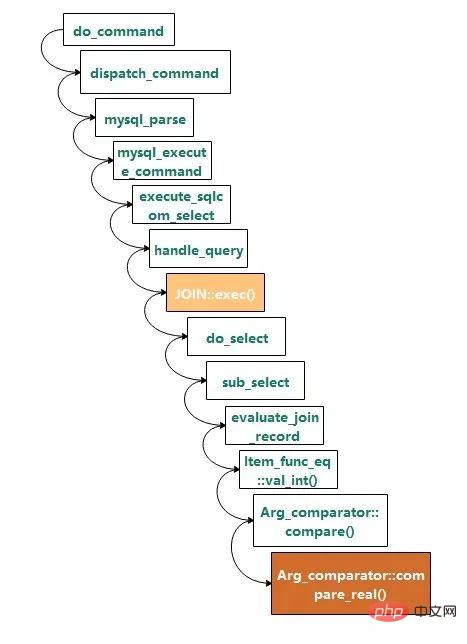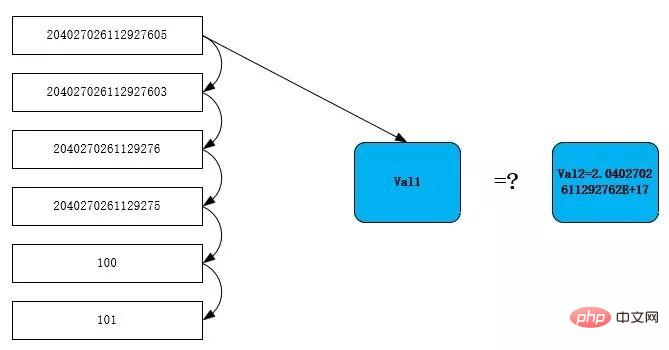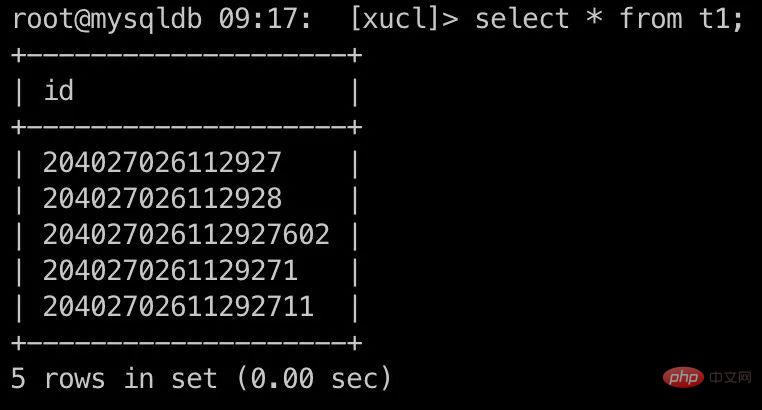看看 MySQL令人咋舌的隐式转换
mysql教程栏目介绍相关的隐式转换

更多相关免费学习推荐:mysql教程(视频)
一、问题描述
root@mysqldb 22:12: [xucl]> show create table t1\G
*************************** 1. row ***************************
Table: t1
Create Table: CREATE TABLE `t1` (
`id` varchar(255) DEFAULT NULL
) ENGINE=InnoDB DEFAULT CHARSET=utf8
1 row in set (0.00 sec)
root@mysqldb 22:19: [xucl]> select * from t1;
+--------------------+
| id |
+--------------------+
| 204027026112927605 |
| 204027026112927603 |
| 2040270261129276 |
| 2040270261129275 |
| 100 |
| 101 |
+--------------------+
6 rows in set (0.00 sec)奇怪的现象:
root@mysqldb 22:19: [xucl]> select * from t1 where id=204027026112927603; +--------------------+ | id | +--------------------+ | 204027026112927605 | | 204027026112927603 | +--------------------+ 2 rows in set (0.00 sec)

什么鬼,明明查的是204027026112927603,为什么204027026112927605也出来了
二、源码解释
堆栈调用关系如下所示:

其中JOIN::exec()是执行的入口,Arg_comparator::compare_real()是进行等值判断的函数,其定义如下
int Arg_comparator::compare_real()
{
/*
Fix yet another manifestation of Bug#2338. 'Volatile' will instruct
gcc to flush double values out of 80-bit Intel FPU registers before
performing the comparison.
*/
volatile double val1, val2;
val1= (*a)->val_real();
if (!(*a)->null_value)
{
val2= (*b)->val_real();
if (!(*b)->null_value)
{
if (set_null)
owner->null_value= 0;
if (val1 < val2) return -1;
if (val1 == val2) return 0;
return 1;
}
}
if (set_null)
owner->null_value= 1;
return -1;
}比较步骤如下图所示,逐行读取t1表的id列放入val1,而常量204027026112927603存在于cache中,类型为double类型(2.0402702611292762E+17),所以到这里传值给val2后val2=2.0402702611292762E+17。

当扫描到第一行时,204027026112927605转成doule的值为2.0402702611292762e17,等式成立,判定为符合条件的行,继续往下扫描,同理204027026112927603也同样符合

如何检测string类型的数字转成doule类型是否溢出呢?这里经过测试,当数字超过16位以后,转成double类型就已经不准确了,例如20402702611292711会表示成20402702611292712(如图中val1)


MySQL string转成double的定义函数如下:
{
char buf[DTOA_BUFF_SIZE];
double res;
DBUG_ASSERT(end != NULL && ((str != NULL && *end != NULL) ||
(str == NULL && *end == NULL)) &&
error != NULL);
res= my_strtod_int(str, end, error, buf, sizeof(buf));
return (*error == 0) ? res : (res < 0 ? -DBL_MAX : DBL_MAX);
}真正转换函数my_strtod_int位置在dtoa.c(太复杂了,简单贴个注释吧)
/*
strtod for IEEE--arithmetic machines.
This strtod returns a nearest machine number to the input decimal
string (or sets errno to EOVERFLOW). Ties are broken by the IEEE round-even
rule.
Inspired loosely by William D. Clinger's paper "How to Read Floating
Point Numbers Accurately" [Proc. ACM SIGPLAN '90, pp. 92-101].
Modifications:
1. We only require IEEE (not IEEE double-extended).
2. We get by with floating-point arithmetic in a case that
Clinger missed -- when we're computing d * 10^n
for a small integer d and the integer n is not too
much larger than 22 (the maximum integer k for which
we can represent 10^k exactly), we may be able to
compute (d*10^k) * 10^(e-k) with just one roundoff.
3. Rather than a bit-at-a-time adjustment of the binary
result in the hard case, we use floating-point
arithmetic to determine the adjustment to within
one bit; only in really hard cases do we need to
compute a second residual.
4. Because of 3., we don't need a large table of powers of 10
for ten-to-e (just some small tables, e.g. of 10^k
for 0 <= k <= 22).
*/既然是这样,我们测试下没有溢出的案例
root@mysqldb 23:30: [xucl]> select * from t1 where id=2040270261129276; +------------------+ | id | +------------------+ | 2040270261129276 | +------------------+ 1 row in set (0.00 sec) root@mysqldb 23:30: [xucl]> select * from t1 where id=101; +------+ | id | +------+ | 101 | +------+ 1 row in set (0.00 sec)
结果符合预期,而在本例中,正确的写法应当是
root@mysqldb 22:19: [xucl]> select * from t1 where id='204027026112927603'; +--------------------+ | id | +--------------------+ | 204027026112927603 | +--------------------+ 1 row in set (0.01 sec)
三、结论
避免发生隐式类型转换,隐式转换的类型主要有字段类型不一致、in参数包含多个类型、字符集类型或校对规则不一致等
隐式类型转换可能导致无法使用索引、查询结果不准确等,因此在使用时必须仔细甄别
数字类型的建议在字段定义时就定义为int或者bigint,表关联时关联字段必须保持类型、字符集、校对规则都一致
最后贴一下官网对于隐式类型转换的说明吧
1、If one or both arguments are NULL, the result of the comparison is NULL, except for the NULL-safe <=> equality comparison operator. For NULL <=> NULL, the result is true. No conversion is needed. 2、If both arguments in a comparison operation are strings, they are compared as strings. 3、If both arguments are integers, they are compared as integers. 4、Hexadecimal values are treated as binary strings if not compared to a number. 5、If one of the arguments is a TIMESTAMP or DATETIME column and the other argument is a constant, the constant is converted to a timestamp before the comparison is performed. This is done to be more ODBC-friendly. This is not done for the arguments to IN(). To be safe, always use complete datetime, date, or time strings when doing comparisons. For example, to achieve best results when using BETWEEN with date or time values, use CAST() to explicitly convert the values to the desired data type. A single-row subquery from a table or tables is not considered a constant. For example, if a subquery returns an integer to be compared to a DATETIME value, the comparison is done as two integers. The integer is not converted to a temporal value. To compare the operands as DATETIME values, use CAST() to explicitly convert the subquery value to DATETIME. 6、If one of the arguments is a decimal value, comparison depends on the other argument. The arguments are compared as decimal values if the other argument is a decimal or integer value, or as floating-point values if the other argument is a floating-point value. 7、In all other cases, the arguments are compared as floating-point (real) numbers.
Atas ialah kandungan terperinci 看看 MySQL令人咋舌的隐式转换. Untuk maklumat lanjut, sila ikut artikel berkaitan lain di laman web China PHP!

Alat AI Hot

Undresser.AI Undress
Apl berkuasa AI untuk mencipta foto bogel yang realistik

AI Clothes Remover
Alat AI dalam talian untuk mengeluarkan pakaian daripada foto.

Undress AI Tool
Gambar buka pakaian secara percuma

Clothoff.io
Penyingkiran pakaian AI

AI Hentai Generator
Menjana ai hentai secara percuma.

Artikel Panas

Alat panas

Notepad++7.3.1
Editor kod yang mudah digunakan dan percuma

SublimeText3 versi Cina
Versi Cina, sangat mudah digunakan

Hantar Studio 13.0.1
Persekitaran pembangunan bersepadu PHP yang berkuasa

Dreamweaver CS6
Alat pembangunan web visual

SublimeText3 versi Mac
Perisian penyuntingan kod peringkat Tuhan (SublimeText3)

Topik panas
 Bagaimana untuk menggunakan sandaran dan pemulihan MySQL dalam PHP?
Jun 03, 2024 pm 12:19 PM
Bagaimana untuk menggunakan sandaran dan pemulihan MySQL dalam PHP?
Jun 03, 2024 pm 12:19 PM
Membuat sandaran dan memulihkan pangkalan data MySQL dalam PHP boleh dicapai dengan mengikuti langkah berikut: Sandarkan pangkalan data: Gunakan arahan mysqldump untuk membuang pangkalan data ke dalam fail SQL. Pulihkan pangkalan data: Gunakan arahan mysql untuk memulihkan pangkalan data daripada fail SQL.
 Bagaimana untuk mengoptimumkan prestasi pertanyaan MySQL dalam PHP?
Jun 03, 2024 pm 08:11 PM
Bagaimana untuk mengoptimumkan prestasi pertanyaan MySQL dalam PHP?
Jun 03, 2024 pm 08:11 PM
Prestasi pertanyaan MySQL boleh dioptimumkan dengan membina indeks yang mengurangkan masa carian daripada kerumitan linear kepada kerumitan logaritma. Gunakan PreparedStatements untuk menghalang suntikan SQL dan meningkatkan prestasi pertanyaan. Hadkan hasil pertanyaan dan kurangkan jumlah data yang diproses oleh pelayan. Optimumkan pertanyaan penyertaan, termasuk menggunakan jenis gabungan yang sesuai, membuat indeks dan mempertimbangkan untuk menggunakan subkueri. Menganalisis pertanyaan untuk mengenal pasti kesesakan; gunakan caching untuk mengurangkan beban pangkalan data;
 Bagaimana untuk memasukkan data ke dalam jadual MySQL menggunakan PHP?
Jun 02, 2024 pm 02:26 PM
Bagaimana untuk memasukkan data ke dalam jadual MySQL menggunakan PHP?
Jun 02, 2024 pm 02:26 PM
Bagaimana untuk memasukkan data ke dalam jadual MySQL? Sambung ke pangkalan data: Gunakan mysqli untuk mewujudkan sambungan ke pangkalan data. Sediakan pertanyaan SQL: Tulis pernyataan INSERT untuk menentukan lajur dan nilai yang akan dimasukkan. Laksanakan pertanyaan: Gunakan kaedah query() untuk melaksanakan pertanyaan sisipan Jika berjaya, mesej pengesahan akan dikeluarkan.
 Bagaimana untuk membuat jadual MySQL menggunakan PHP?
Jun 04, 2024 pm 01:57 PM
Bagaimana untuk membuat jadual MySQL menggunakan PHP?
Jun 04, 2024 pm 01:57 PM
Mencipta jadual MySQL menggunakan PHP memerlukan langkah berikut: Sambung ke pangkalan data. Buat pangkalan data jika ia tidak wujud. Pilih pangkalan data. Buat jadual. Laksanakan pertanyaan. Tutup sambungan.
 Bagaimana untuk menggunakan prosedur tersimpan MySQL dalam PHP?
Jun 02, 2024 pm 02:13 PM
Bagaimana untuk menggunakan prosedur tersimpan MySQL dalam PHP?
Jun 02, 2024 pm 02:13 PM
Untuk menggunakan prosedur tersimpan MySQL dalam PHP: Gunakan PDO atau sambungan MySQLi untuk menyambung ke pangkalan data MySQL. Sediakan penyata untuk memanggil prosedur tersimpan. Laksanakan prosedur tersimpan. Proses set keputusan (jika prosedur tersimpan mengembalikan hasil). Tutup sambungan pangkalan data.
 Bagaimana untuk membetulkan ralat mysql_native_password tidak dimuatkan pada MySQL 8.4
Dec 09, 2024 am 11:42 AM
Bagaimana untuk membetulkan ralat mysql_native_password tidak dimuatkan pada MySQL 8.4
Dec 09, 2024 am 11:42 AM
Salah satu perubahan utama yang diperkenalkan dalam MySQL 8.4 (keluaran LTS terkini pada 2024) ialah pemalam "Kata Laluan Asli MySQL" tidak lagi didayakan secara lalai. Selanjutnya, MySQL 9.0 mengalih keluar pemalam ini sepenuhnya. Perubahan ini mempengaruhi PHP dan apl lain
 Perbezaan antara pangkalan data oracle dan mysql
May 10, 2024 am 01:54 AM
Perbezaan antara pangkalan data oracle dan mysql
May 10, 2024 am 01:54 AM
Pangkalan data Oracle dan MySQL adalah kedua-dua pangkalan data berdasarkan model hubungan, tetapi Oracle lebih unggul dari segi keserasian, skalabiliti, jenis data dan keselamatan manakala MySQL memfokuskan pada kelajuan dan fleksibiliti dan lebih sesuai untuk set data bersaiz kecil. ① Oracle menyediakan pelbagai jenis data, ② menyediakan ciri keselamatan lanjutan, ③ sesuai untuk aplikasi peringkat perusahaan ① MySQL menyokong jenis data NoSQL, ② mempunyai langkah keselamatan yang lebih sedikit, dan ③ sesuai untuk aplikasi bersaiz kecil hingga sederhana.
 Cara menggunakan bool dalam bahasa c
May 09, 2024 pm 01:00 PM
Cara menggunakan bool dalam bahasa c
May 09, 2024 pm 01:00 PM
Jenis bool dalam bahasa C mewakili benar/salah, dan nilainya ialah 1 (benar) atau 0 (salah). Anda boleh menggunakan bool is_true = benar untuk mengisytiharkan dan memulakan pembolehubah Boolean, atau anda boleh menggunakan kata kunci benar/salah. Pembolehubah Bool boleh menggunakan operasi NOT, AND, OR dan XOR logik. Ungkapan bool digunakan dalam pernyataan bersyarat dan gelung. Jenis bool boleh ditukar secara tersirat kepada jenis int (1: true, 0: false); jenis int juga boleh ditukar secara tersirat kepada jenis bool (bukan sifar: true, 0: false).






